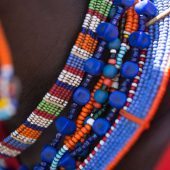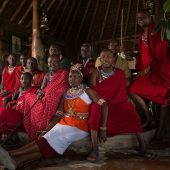Maasai
Maasai people
Maasai (not Masai or Massai) is the correct spelling of this noble tribe: it means people speaking maa. Masai was the incorrect spelling of the British settlers and has remained in current use. Kenya recognizes over forty tribes of native people. The Maasai were the dominating tribe at beginning of the 20th century. They are one of the very few tribes who have retained most of their traditions, lifestyle, and lore.
The Maasai have always been special. Their bright red robes set them apart visually. Spear in hand, they are calm and courageous regardless of the danger. The armed British troops who drove the Maasai from their lands in the early 20th century had great respect for these fearless tribesmen. Up until recently, the only way for a Maasai boy to achieve warrior status was to single-handedly kill a lion with his spear.
By choosing Chyulu Wilderness Camp for your Kenya safari, you will not only enjoy a unique and pristine wilderness and amazing wildlife, but you’ll actively protect them and help the Maasai community.
When you see a Maasai for the first time, you will likely agree with what Karen Blixen (Isak Dinesen) wrote about her experience in East Africa in her book Out of Africa:
“A Maasai warrior is a fine sight. Those young men have, to the utmost extent, that particular form of intelligence which we call chic; daring and wildly fantastical as they seem, they are still unswervingly true to their own nature, and to an immanent ideal. Their style is not an assumed manner, nor an imitation of a foreign perfection; it has grown from the inside, and is an expression of the race and its history, and their weapons and finery are as much a part of their being as are a stag’s antlers.”
A bit of Maasai tribe history
In common with the wildlife with which they co-exist, the Maasai need a lot of land. Unlike many other tribes in Kenya, the Maasai are semi-nomadic and pastoral: they live by herding cattle and goats. The Maasai’s god is Engai. They believe he created them, gave them all the cattle in the world, and later made other human beings. The Maasai refer to the neighboring tribes of farmers and hunter-gatherers as “Ndorobo,” meaning poor folk. Maasai measure wealth by the number of cattle, so people without cattle are considered poor. Maasai did not have villages with permanent buildings. Instead, they constructed an “enkang” (corral) for a group of families. The “enkang” is a circle of huts, one per family, enclosed by a circular fence of thorn bushes. The woman of each household constructs the hut from cattle dung and clay. Periodically, the groups would abandon their “enkang” and construct a new one in an area with better water and grazing. This old way of nomadism is almost gone, there is no more land where to roam to.
“Laibon” can be roughly translated from Maa in “witch doctor;” a better word would be “vision seeker”. Laiboni were spiritual leaders, with an ability to divine the future.
Mbatiany in the last part of the 19th century had a tremendous vision: a metal snake was coming up from the Coast, with people whose skin was the color of flamingos. If it was coming things would have never been the same again for the Maasai. He wanted to stop the snake, but the warriors had no fear and told him to let it come. He was unfortunately right. The train (the metal snake he dreamt of) arrived in the last decade of 19th Century, just a few years after Mbatiany death. Through forcing his two sons, Olonana (aka Lenana) and Senteu, in land agreements, the colonial administration deprived the Maasai of their best land.
The Maasai have not fared well in modern Africa. Until the European settlers arrived, fierce Maasai tribes occupied the most fertile lands. The Maasai struggled to preserve their territory, but their spears were no match for armed British troops, and their lawyers never had a fair chance in British courtrooms. In 1904, the Maasai signed the first agreement, losing the best of their land to the European settlers. Seven years later, in 1911, a very controversial agreement was signed by a small group of Maasai, where their best Northern land (Laikipia) was given up to white settlers. Surely they did not fully understand what the consequences of such a treaty were, and anyway the signatories did not represent the entire tribe. With these two treaties, the Maasai lost about two-thirds of their lands and were relocated to less fertile parts of Kenya and Tanzania.
Which future for Maasai tribe?
Other tribes of Kenya have adapted more readily to the “progress” of modern times. In contrast, the Maasai have persisted in their traditional ways, so as Kenya takes more land for growing tribes and agriculture, they suffer. One positive trend for the Maasai in recent years has been the development of a specific form of eco-tourism. Although other tribes in Kenya regard wildlife as food or a menace to their crops, the Maasai have proven to be able to co-exist with wildlife.
But less land for an ever-growing Kenyan population means less land for the Maasai, their livestock, and wildlife.
More and more, a lion will take a cow or some goats and get killed in retaliation. While in the past the retaliatory killing by poisoning was unheard of, and lions were bravely hunted on foot by warriors simply armed with spears, nowadays poisoning has become a common and very effective method. Carcasses of livestock get poisoned with a chip pesticide, easily available in the market.
Lions are a disappearing species: their numbers plunged from an estimated population of 400,000 in mid-20th century, to as few as 23,000, with a range of 16,500-30,000, nearly 15 years ago (Bauer and Van Der Merwe 2004).
Maasai Wilderness Conservation Trust has pioneered a compensation program, reimbursing livestock killed by lions (and other predators). The program is called Wildlife Pays and it is supported by tourists’ conservation fees; it employs warriors as lions scout (more lions = more employment). It is a cutting edge tourism Payment for Ecosystem Service, where tourists fund conservation, through their stay at Chyulu Wilderness Camp – totally sustainable and not depending on a single $ of philanthropy.
In the past, the Maasai and the wildlife simply lived together, in balance. If this could be re-established, by showing to the Maasai the economic value of the presence of wildlife in their land, the future of the land, of the wildlife, and of the Maasai people will be assured.












